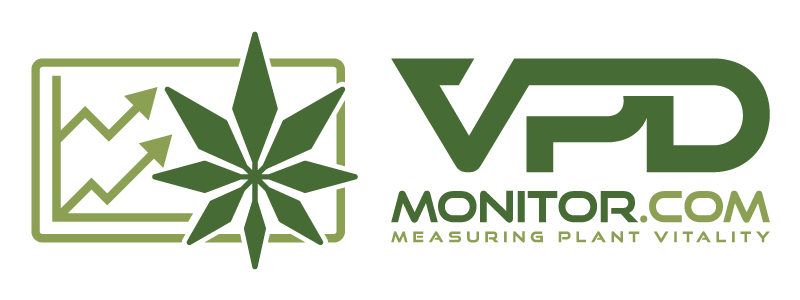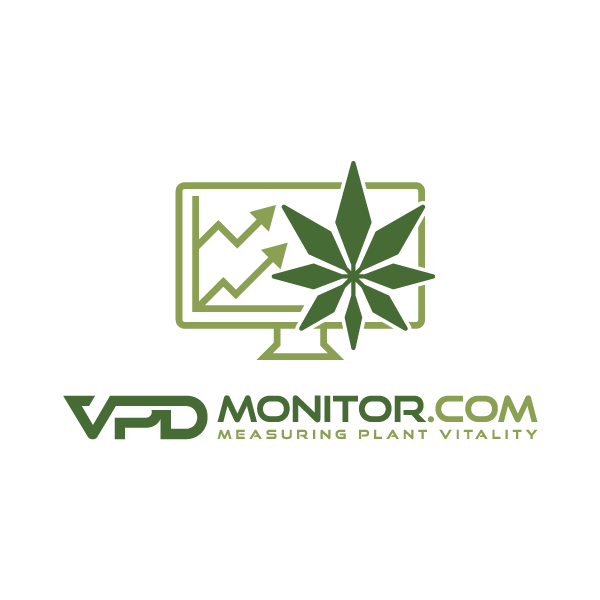How to use VPD…
How to use VPD in different grow room environments
This application note is intended as a guide for users of a VPD monitor, in understanding VPD (Vapour Pressure Deficit) and its use in climate control applications.
1. What is VPD??
2. VPD and Plant Stress
3. Analysing VPD
4. Controlling VPD
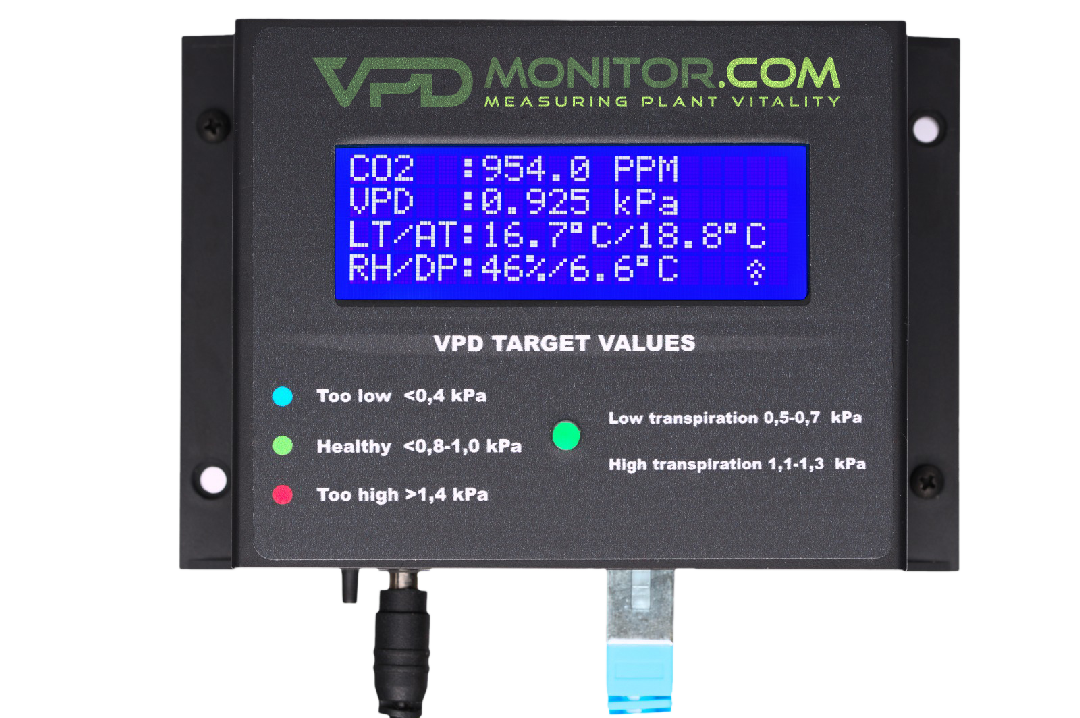
Introduction
This application note is intended as a guide for users of a VPD monitor, in understanding VPD (Vapour Pressure Deficit) and its use in climate control applications. VPD measurements can provide an indication of the current evaporation potential of the air, and as such can be useful in environmental control applications for horticulture.
VPD readings can be used in applications where indications of the current or accumulated plant evaporation potential are required. It is particularly useful:
- As an indicator of crop stress that can be used to drive control decisions to shade, cool, or heat the
crop in order to modify this stress - As a component of irrigation management to satisfy the water loss that is predicted by this stress
indicator - Predicting the evaporation rate for other processes such as crop drying
- Regulating fog or mist delivery.
- Regulating CO2 delivery.
For example: when the VPD is high, a humidifier can be left on for longer pulses without wetting the crop or the ground since the fog will evaporate before it has time to contact solid surfaces.
VPD alone does not provide a perfect model of plant water stress, and there has been a tendency in the past to rely too heavily upon calculated VPD alone for irrigation and environmental control purposes. However, if the measurements for calculation of VPD are taken in a manner that provides an accurate representation of the current crop conditions, and this information is then applied in an equally careful manner, it can be used to influence key environmental control management decisions!
What is VPD??
VPD stands for Vapor Pressure Deficit. To understand VPD we must first understand the concept of vapor pressure and how it relates to humidity. Most of u s are familiar with the concept of relative humidity . It is the ratio of actual water in the air to the theoretical saturation point at the current air temperature, expressed as a percentage. The saturation point is the maximum amount of water vapor that an air mass can hold at a given temperature and pressure. Anything in excess of the saturation point will condense out as liquid water. Therefore, whenever you see condensation or ‘dew’’ on the surface of an object, it indicates that the air immediately surrounding that surface has become cooled
to below its saturation point, causing some of the water vapor to condense into its liquid form. The saturation point is also called ‘dew point’’.
What does pressure have to do with humidity??
Vapor pressure is a different way of thinking about humidity. Air typically contains about 1 – 4% water vapor. All gasses in the air exert a pressure. The combination of theses gasses including water vapor produce a pressure at sea level of about 1013 mb. Within this total, water vapor pressure accounts for about 2 mb (millibars) under extremely dry and cold conditions to about 42 mb of pressure at 30 C and 100% relative humidity.
Vapor Pressure Deficit or VPD is a measure of the difference (or deficit) between the pressure exerted by the moisture currently in the air and the pressure at saturation. VPD units are most often expressed in standard pressure units such as millibars, kilopascals, or pounds per square inch. This system uses kilopascal as the default measurement unit.
Why not just use Relative Humidity?? In many situations you can. At any fixed air and leaf temperature and pressure, there is an excellent inverse relationship between RH and VPD. For this reason, many growers simply use RH values for the same purposes with good results. However, if the air temperatures change significantly, VPD can provide a more accurate indication of the current evaporation potential since it combines the effects of both temperature and humidity into a single value.
A full explanation of the complex relationships between solar radiation, plants, air, and water vapor would require examination of thermodynamics, the gas laws, and the properties of the psychrometric chart, not to mention the biochemical and morphological properties of the plant. Without resorting to that, the following diagram attempts to illustrate the general effects disturbances such as applied heat, solar radiation, evaporation, and ventilation will have on other climate parameters.
Whenever the relative humidity increases the VPD value decreases. Although the two are related, VPD measurement is somewhat superior to relative humidity measurement in certain applications since it combines the effects of temperature and pressure into a single value. For example, under certain conditions, a plant may experience more water loss on a warm day with High RH than on a cool day with low RH.
VPD is a good indicator of plant stress brought about by either excessive transpiration (high VPD values) or the inability to transpire adequately (low VPD values).
While plants are affected by changes in the surrounding air mass, they can also actively affect this same air mass. Whenever plants increase their own rate of transpiration a local decrease in the VPD will occur as the surrounding air absorbs this evaporated moisture. There is also an associated cooling effect as the process of water evaporation absorbs a lot of heat. This cooling will further reduce the water holding capacity of the air mass and thus lower the VPD value.
A mature crop with a full leaf canopy can handle most of the cooling load in a greenhouse. To witness this, just stand in an empty greenhouse on a hot sunny day (under full venting) and then stand in one filled with plants. The one filled with plants will be several degrees cooler and the VPD will be lower. In this situation, the primary purpose of the ventilation system is to bring in dryer air to allow the evaporation process to continue; not to bring in cooler air to cool the greenhouse through sensible heat transfer. The reduction in ventilation requirements saves operating costs and also facilitates insect exclusion (less insect screen required) and improves CO2 enrichment efficiency (less CO2 losses).
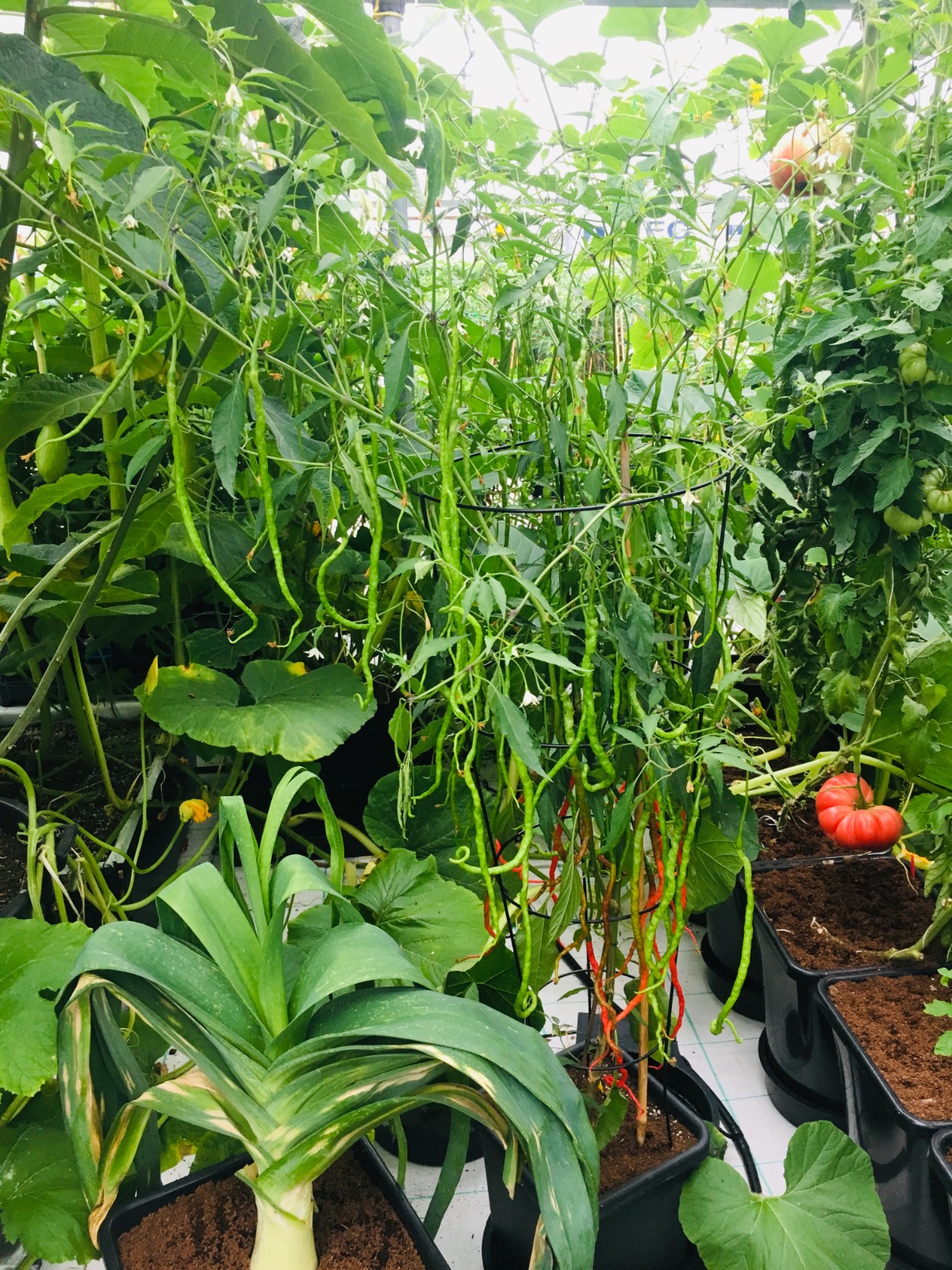
VPD and Plant Stress
Plants absorb CO2 and evaporate water into the atmosphere via the leaf stomata. Guard cells surrounding each stomata open and close to regulate the amount of water evaporation and gas exchange. The opening and closing mechanism is controlled by water pressure within the guard cells .Pairs of guard cells are joined at the ends and when they inflate with water , they bow outward leaving a hole like the middle of an inflated inner tube. When the guard cells lose water, they collapse together, closing the opening. In this manner, the stomata will naturally tend to be closed whenever the plant is under water stress due to drought, heat, or low humidity.
The stomata will also close in the daytime whenever the plant is losing too much water to maintain the turgidity of the guard cells. This action helps the plant reach its primary objective of reducing water loss. However, it consequently reduces or stops photosynthesis and allows leaf temperatures to rise as the plant tries to preserve its water balance and prevent permanent wilting.
CO 2 also affects the opening amount. High CO2 levels will cause the stomata to close. The stomata are normally opened in the daytime during photosynthesis since the leaf air spaces tend to be starved of CO2.
This enables CO2 to be absorbed from the surrounding air. The stomata typically close at night due to high levels of CO2 in the leaf air spaces , since photosynthesis has stopped while respiration continues, flooding these spaces with internally produced CO2.
VPD Does Not Measure Plant Stress!!
Remember , VPD is not an actual measurement of plant stress or water loss , it is only an indirect indicator. VPD alone can’t tell you if your crop is currently ‘happy’’ or wilting due to underlying problems such as root disease or acclimatization issues.
VPD Does Not Measure Plant Water Use!!
VPD can only tell you about the potential for water to evaporate from the leaves. There are several other factors that affect water transport including salinity in the rooting media, root health, and whether the leaf stomata are opened or closed. Although the actual rate of water loss is not directly proportional to VPD, there is a general relationship.
It can tell you whether the crop is experiencing drying conditions and you can then make some assumptions based on this. However, the actual rate of water movement through the plant is controlled by three major contributing factors, and VPD has a role in only the first one:
Stomata
1. Transpiration losses caused by the leaf (stomata)) responses to the immediate surrounding environment. Contributing factors include : VPD, temperature, solar radiation, wind speed, and CO 2 levels.
Water
2. Water availability and water uptake . This is affected by soil water availability, salinity (osmotic pressure ) and root system structure and health.
Root and Shoot
3. Transport mechanisms between the “root and the shoot” including the structure and health of the vascular system.
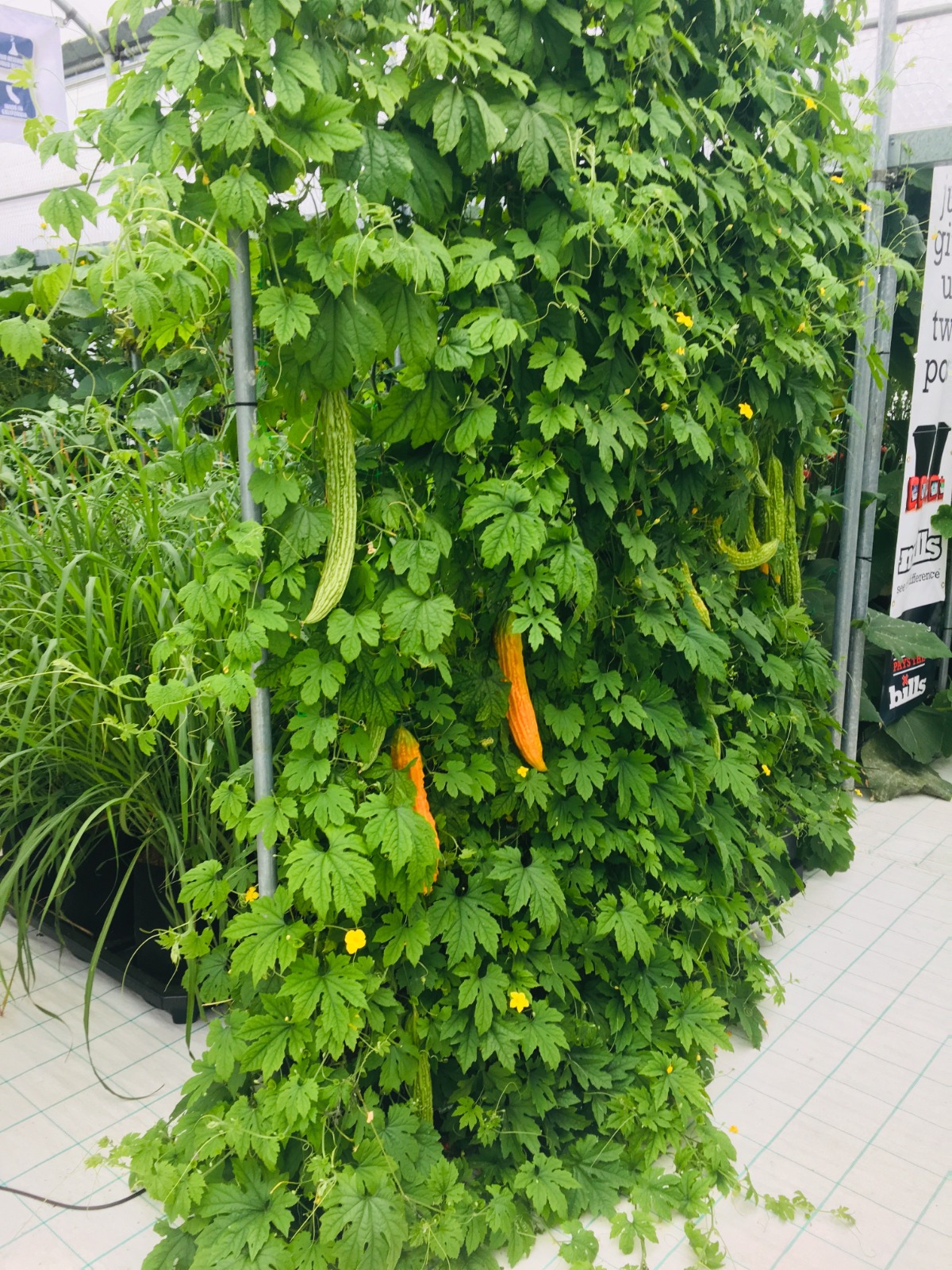
Analysis of VPD
VPD Too Low
When the VPD is too low ( humidity too high) plants are unable to evaporate enough water to enable the transport of minerals (such as calcium) to growing plant cells, even though the stomata may be fully open. Therefore, a VPD target threshold can be used to influence ventilation and/or heating equipment used to increase the VPD by reducing the air moisture level.
In cases where the VPD is extremely low, water may condense out of the air onto leaves, fruit, and other plant parts. This can provide a medium for fungal growth and disease.
Under low VPD conditions, some plants may even exude water from their leaf cells in a process called guttation.
When plants are unable to evaporate water, excessive turgor pressure within the cells can cause splitting and cracking of fruits such as tomatoes.
In cases where the VPD alternates between too high and too low, fruit quality can be adversely affected by ‘shrink cracks’’ in the skin as the turgor pressure alternately expands and contracts the water – filled cells in the fruit. Most of these conditions are detrimental.
VPD Too High
When the VPD is too high (humidity too low) the rate of evaporation from the leaves can exceed the supply of water into the roots. This in turn will cause the stomata to close, and photosynthesis to slow or stop. Once the stomata close, the leaves are at risk of high temperature injury since evaporative cooling is reduced due to the lack of water to evaporate.
To avoid injury and death from wilting, many plant species will either curl their leaves or orient them downward in an attempt to expose less surface area to the sun. This can significantly downgrade the quality of potted and foliage plants and can also reduce the growth rate and quality of vegetable crops.
The ideal VPD range varies with the crop species and the stage of growth. The table below indicates VPD values in millibars at various temperatures and humidity levels . Although the values do not change, the interpretation of the numbers will vary for each crop species, the stage of growth, cultivation methods, crop acclimatization, and local conditions. We have arbitrarily selected the green shaded area (approximately 5.0 to 12.0 mb)) as being ideal for an imaginary crop. The yellow areas indicate an acceptable but marginal VPD rang e and the red areas are either too high or too low. Again, you need to make your own interpretations for your crops.
You can think of these VPD numbers as an indication of the current evaporation potential. As the number increases so does the evaporation potential. Remember, this may not correspond exactly to the actual rate of water loss, particularly in extremely high VPD conditions.
Notice that VPD can potentially provide a better indication of the evaporation potential than RH. For example, as the temperature climbs from 15 to 35 ˚ C at a constant 75% RH, the VPD will range from a bit on the low side (44.2) to too high (114). Since this digression is much less noticeable when the crop temperature only varies over a few degrees, it allows many growers to produce fairly good results using just RH measurements.
However, even in these cases it may be possible to improve crop performance and /or reduce energy costs through the tighter management that is possible b y using VPD measurements directly.
Note: Low VPDs may be acceptable for short periods of time such as the early morning hours when the plant is not actively photosynthesizing provided there are no problems with condensation on plant or greenhouse surfaces, or guttation on leaves. Likewise, short periods of high VPDs may be OK if the plant is healthy and well supplied with water.
The VPD Monitor will calculate the VPD for any temperature sensor linked to a representative humidity sensor reading.
To measure the actual leaf VPD, you would need to accurately measure the temperature of the leaf tissue. While not impossible, this is seldom practical, since leaf temperatures can vary wildly throughout a crop as some leaves are in shade and others in full sunlight.. This makes it very hard to find a representative leaf to measure.
To calculate the actual VPD, the VPD monitor uses the climate temperature(ambient temperature) reading and the climate humidity reading from an aspirated sensor module that is properly positioned above the crop, combined with an infrared temperature sensor measuring actual leave temperature.
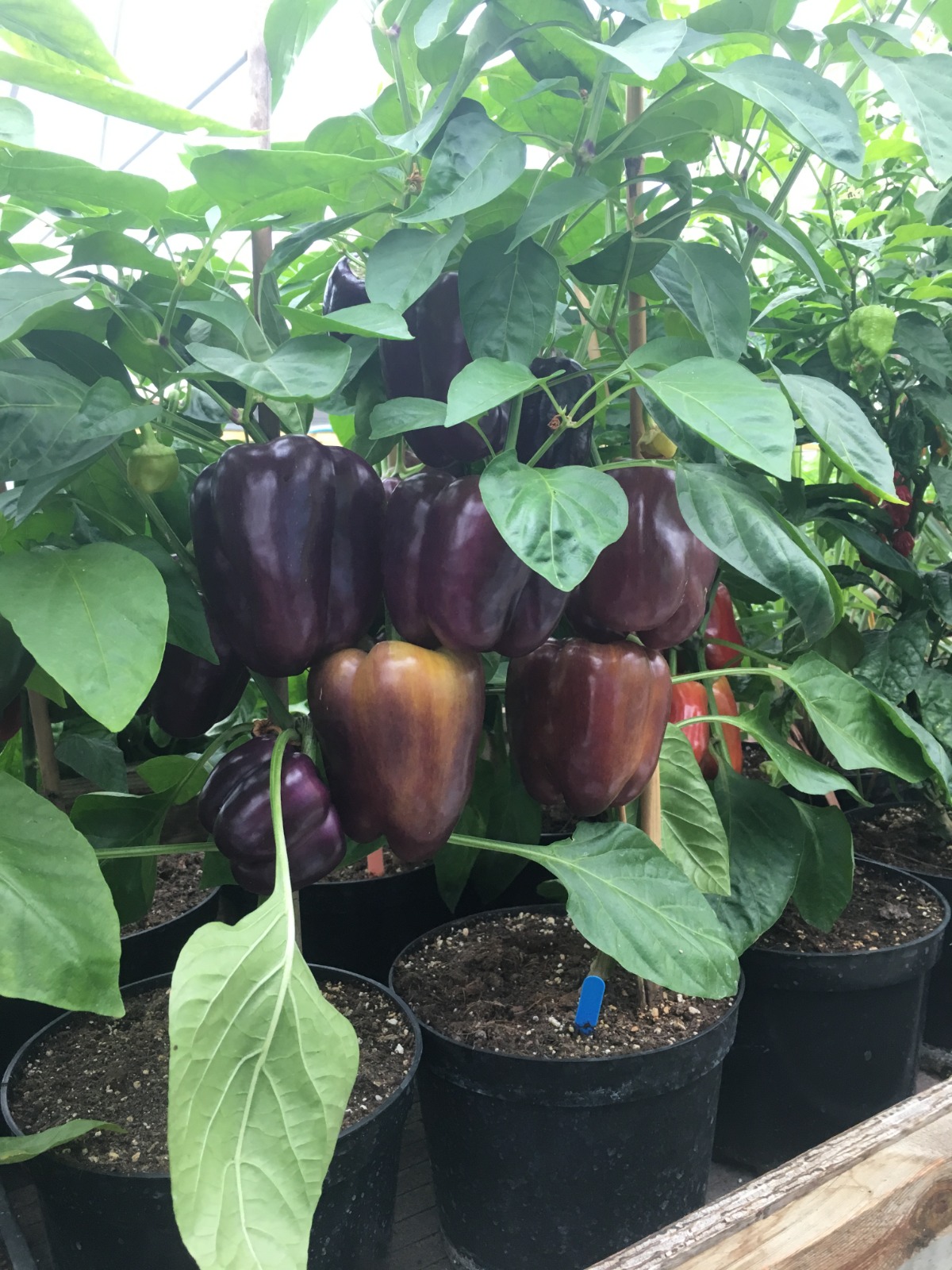
Using VPD Values
The successful use of VPD calculations depends upon good representative measurements, careful application of this information in control programs, and tuning the control response based on your observations. There are several things you can do with this information. Here are some ideas:
Control
Although VPD can indicate whether the current evaporation stress on the plants appears to be too high or low, it can’t tell you the reason, since the effect is a combination of temperature and humidity.
Therefore, using VPD for direct feedback control of temperature or humidity is not usually practical. However, you can still use VPD to influence climate management strategies, and as the basis for operating humidification equipment such as fog and mist systems.
Controlling High VPD
In high VPD situations, you can use the current VPD reading to directly operate fog or misting equipment to add water vapor to the air while simultaneously cooling the air through evaporation. Both these effects will reduce VPD values and evaporation stress in the crop. Any consequential air temperature or relative humidity changes will be looked after by your standard temperature and humidity climate control strategies.
A misting program based on VPD is capable of regulating the on time of the fog or mist nozzles to provide the maximum amount of water for evaporative cooling and VPD setpoint control while minimizing plant and soil wetting.
Controlling Low VPD
In situations where the VPD is too low, moisture must be removed from the air or the air moisture holding capacity must be increased through a rise in temperature. Moisture removal can be accomplished directly through the use of dehumidifiers or by replacing the moist air with drier air (typically through ventilation) . The need for this is normally established using relative humidity measurements alone, and it is the standard practice for avoiding direct condensation onto crop or greenhouse surfaces.
SUMMARY
In conclusion, VPD can be a useful tool for assessing the evaporation potential in the crop and for monitoring conditions that produce evaporation stress. With careful observation and application, it can also be used to drive automatic equipment control processes.
However, VPD is just an indicator. It is not a direct measurement of plant water transport or the current evaporation rate.
1. Measure
Make sure that the measured temperature and humidity readings used to calculate VPD are representative of the crop conditions.
2. Optimise
Adjust climate conditions for optimum VPD both day and night where necessary. Reduce the impact of the highs and lows in your cropcycle to maintain maximum plant vitality.
3. Control
Use data recording and alarms to monitor VPD readings and any resulting control actions.. Use this information to inform crop production decisions. Make sure you are getting the expected results.
4. Observe
Carefully observe the crop over time and tune the control response as necessary.

